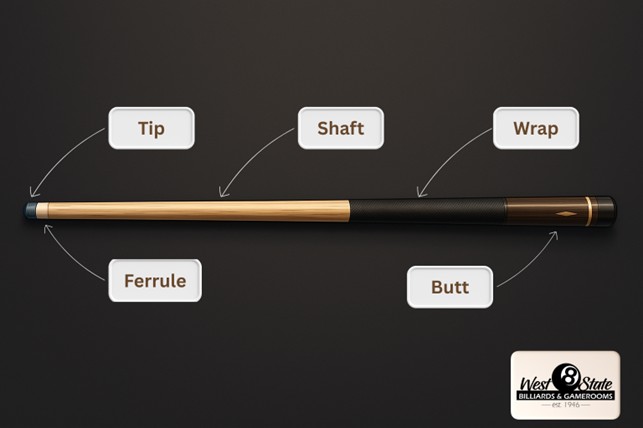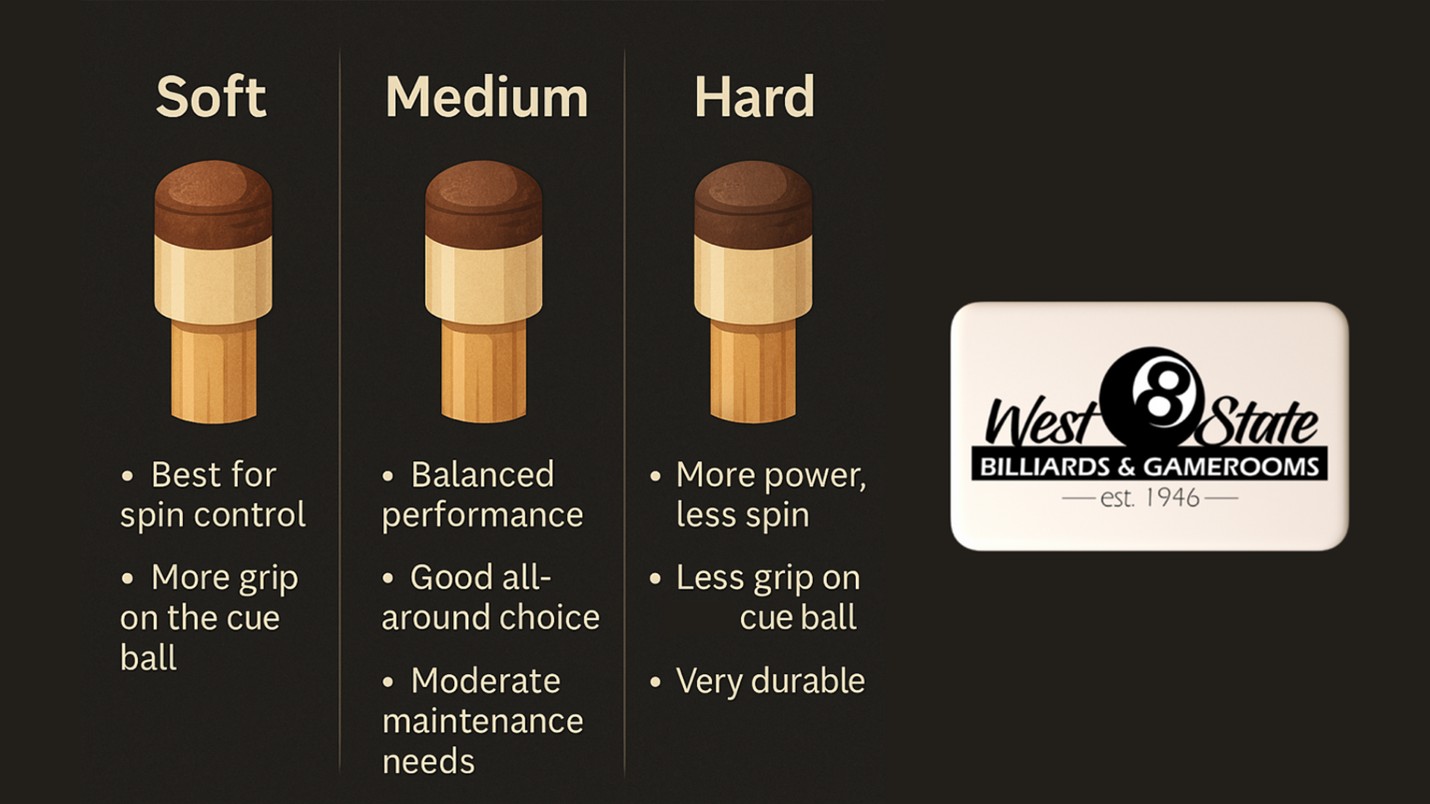Find Your Perfect Match: A Guide to Selecting the Ideal Pool Cue

Introduction
Picking the right pool cue can make a big difference in how you play. The right cue helps you feel more comfortable and confident, whether you’re just learning or already have some experience. But with so many choices out there, it can be hard to know where to start.
At West State Billiards, we’re here to help. We have showroom locations all across California, and each one is staffed with friendly, knowledgeable people who love the game and know what they’re talking about. They can answer your questions, explain your options, and even let you try out different cues so you can feel the difference for yourself.
Find a West State Billiards showroom near you →
This guide will walk you through the basics of what to look for in a pool cue, from the materials to the design, so you can make a smart choice. And when you’re ready, stop by one of our stores to get expert advice and find your perfect match.
Understanding Pool Cue Anatomy
Before you can choose the right pool cue, it’s important to understand what each part does. A cue isn’t just a stick, it is made up of several parts that work together to give you control, power, and precision during your game. Let’s break down the main components so you know exactly what to look for.

The Tip: Located at the very front of the cue, the tip is the only part that contacts the cue ball—making it one of the most important components for accuracy, spin, and overall control. Cue tips are made from leather and come in different hardness levels (soft, medium, and hard), each affecting how the cue ball reacts. Softer tips grip the ball more and generate more spin (English), while harder tips are more durable and provide a firmer, faster hit with less maintenance. Choosing the right tip can greatly impact your ability to control speed, spin, and shot consistency.
Soft Cue Tips
- Best cue tip for spin control, soft tips allow maximum cue ball grip for applying English.
- Ideal for players focused on finesse shots and precise cue ball positioning.
Medium Cue Tips
- Most versatile pool cue tip, balances control, spin, and power for all-around play.
- Recommended cue tip for beginners and intermediate players due to consistent performance.
Hard Cue Tips
- Best cue tip for power shots, hard tips deliver strong, accurate hits with less deflection.
- Offers long-lasting durability and minimal maintenance for frequent players.
The Ferrule: The ferrule is the small piece between the tip and the shaft of the cue. It acts like a shock absorber, helping to spread out the force when you hit the ball. This protects the shaft from cracking or getting damaged. Most ferrules are made from strong materials like plastic or resin that can handle a lot of impact. A good ferrule also helps give you a smoother, more accurate shot, especially if you use spin or shoot with power.
- Acts as a shock absorber to protect the shaft from cracking or damage.
- Helps deliver smoother, more consistent shots by reducing vibration.
- Made from strong materials like resin or fiber to handle powerful hits.
The Shaft: The shaft is the long, smooth part of the cue that connects the tip and ferrule to the butt. It’s usually made from hard maple wood or carbon fiber and plays a big role in how the cue feels and performs. A good shaft helps you aim better, hit more accurately, and control the cue ball more easily. The shape and thickness of the shaft (called the taper) can also affect your shot. Some shafts are thinner near the tip (pro taper), which can make it easier to add spin, while others are thicker for more stability. Picking the right shaft depends on your playing style and what feels most comfortable in your hand.
- Usually made from maple wood or carbon fiber for strength, smoothness, and control.
- The taper (shape of the shaft) affects how much spin you can apply and how the cue feels during your stroke.
- A well-made shaft helps improve aim, accuracy, and cue ball control for better overall performance.
The Wrap: The wrap is the part of the cue you hold when you shoot. It’s located on the butt of the cue and helps give you a better grip. Wraps are made from different materials, like Irish linen, leather, or even rubber, and each one feels different in your hand. A good wrap helps you stay in control, especially if your hands get sweaty during a game. Some players prefer cues without a wrap for a smoother feel. Choosing the right wrap depends on what feels most comfortable and helps you play your best.
- Improves grip and control, especially during long or intense games.
- Made from materials like Irish linen (smooth), leather (tacky), or rubber (extra grip).
- Choosing the right wrap depends on your personal comfort and how much grip you prefer.
The Butt: The butt is the bottom part of the pool cue, the part farthest from the tip. It is usually made from hardwood and can include decorative features like inlays, rings, or custom designs. While it adds style, the butt also affects how the cue feels and how well it’s balanced. Some butts have weight bolts inside so you can adjust the cue’s weight to match your preference. The very end of the butt has a rubber bumper, which protects the cue from damage if you set it down too hard. A well-designed butt helps with overall control and makes the cue feel solid in your hands.
- Made from strong hardwood and often includes decorative inlays or custom designs.
- Can include adjustable weight bolts to fine-tune the cue’s balance and feel.
- The rubber bumper at the end protects the cue from damage during use and storage.
Determining the Right Weight and Balance
Choosing the right weight and balance for your pool cue is just as important as picking the right materials or tip. The weight of the cue affects how much power and control you have, while the balance point changes how the cue feels during your stroke. Some players prefer a lighter cue for finesse and faster movement, while others like a heavier cue for stronger, more stable shots. Finding the right combination depends on your size, strength, and playing style. Testing different options in person can help you figure out what feels most natural and gives you the best results.
Cue Weight: Standard cues weigh between 18 to 21 ounces.
Lighter Cues (18-19 oz): Facilitate finesse and control, suitable for players who prefer a delicate touch.
Heavier Cues (20-21 oz): Provide more power, ideal for breaking shots and players who favor a forceful playstyle.
Balance Point: The balance point is where the weight of the cue is centered. It affects how the cue feels in your hands when you line up and take a shot. A well-balanced cue feels steady and easy to control, which can help you shoot more accurately. Some cues are forward-balanced, making the tip feel heavier, while others are rear-balanced, which shifts more weight toward your back hand. Everyone has different preferences, so it’s a good idea to try out different cues to see which balance feels the most comfortable and natural for you.
Selecting the Appropriate Shaft Material
The shaft is one of the most important parts of a pool cue, and the material it’s made from can change how the cue feels and performs. Most shafts are made from hard maple wood, but newer options like carbon fiber are becoming more popular. Each material has its own strengths. Some offer better control, while others are built to last longer and resist warping. Understanding the differences can help you choose a shaft that matches your skill level, playing style, and budget.
- Maple wood shafts are traditional, offer a natural feel, and are great for control and precision.
- Carbon fiber shafts are lightweight, very durable, and resist warping over time.
- The right shaft material depends on your playing style, how often you play, and your personal preference.
Choosing the Right Tip
The tip of your pool cue plays a big role in how the cue ball reacts when you shoot. It’s the only part of the cue that touches the ball, so the type of tip you choose can affect your control, spin, and power. Tips come in different hardness levels—soft, medium, and hard—and each one feels and performs differently. Knowing how each type works will help you pick a tip that matches your skill level and the kind of shots you like to make.

Layered vs. Solid Tips:
- Layered Tips: Made from multiple leather layers, offering consistent performance and better shape retention.
- Solid Tips: Single-piece leather tips that are more affordable but may wear unevenly.
Layered tips are a great choice for players looking for long-lasting consistency, while solid tips are fine for casual or budget-conscious players.
Considering Cue Length and Diameter
When choosing a pool cue, it’s important to think about both the length and the diameter of the shaft. These factors affect how the cue feels in your hands and how well you can control your shots. Most cues come in standard sizes, but depending on your height, arm length, and skill level, a different size might work better for you. Understanding how length and diameter impact performance can help you pick a cue that feels natural and helps you play your best.
- Standard cue length is 58 inches, which works well for most adult players.
- Shorter or longer cues may be better for players with different heights or limited space.
- Shaft diameter affects control—thinner shafts offer more spin, while thicker shafts provide stability and are easier for beginners to handle.
Evaluating Wrap Options
The wrap is the part of the cue you grip while playing, and it can make a big difference in comfort and control. Wraps help prevent the cue from slipping, especially if your hands get sweaty during a close game. There are several types of wraps including Irish linen & leather, each offering a different feel and level of grip. Choosing the right wrap comes down to personal preference and what helps you feel most confident when taking your shot.
- Irish Linen Wraps: Provide a smooth texture with moderate grip, suitable for players who prefer a traditional feel.
- Leather Wraps: Offer a tackier grip, absorbing moisture effectively, ideal for players with sweaty hands.
- No Wrap (Wooden Handle): Preferred by some players for its sleek appearance and direct feel of the cue’s wood.
Budget Considerations
When buying a pool cue, your budget plays an important role in finding the right fit. Cues come in a wide range of prices, and spending more doesn’t always mean better performance, especially for newer players. Whether you’re just starting out or ready to invest in something more advanced, it’s important to know what to expect at different price levels. This section will help you understand the differences between entry-level, mid-range, and high-end cues so you can choose one that fits both your needs and your wallet.
Entry-Level Cues ($60 – $200)
If you’re just getting started with pool, an entry-level cue is a smart choice. Cues in this price range offer solid quality without being too expensive. They’re great for beginners, casual players, or anyone who wants something better than a worn-out house cue.
Most entry-level cues are made with maple shafts and include basic features like a leather tip and a wrap for better grip. They provide good control and a more consistent feel than shared cues at a bar or pool hall.
While they may not have advanced technology or fancy designs, these cues are perfect for learning the basics and getting comfortable with your stroke.
A great option to start with is the Prism WS101, available now at West State Billiards.
Mid-Range Cues ($200 – $450)
Mid-range cues are a great choice for players who want better performance and quality without spending a fortune. If you’ve been playing for a while or are starting to take the game more seriously, this range offers a noticeable upgrade from entry-level cues.
These cues often feature higher-quality wood, better construction, and improved balance. Many come with low-deflection shaft, which help you make more accurate shots, especially when using spin. The designs are also more detailed, with custom inlays and better finish work.
Mid-range cues give you more control, more power, and a more professional feel, making them a solid investment for any growing player.
Want to step up your game? Check out the Prism WS103 for a great mix of style, performance, and value.
High-End Cues ($450 and above)
High-end pool cues are made for serious players who want top performance, advanced features, and eye-catching design. If you play often, compete in leagues or tournaments, or simply want the best, this price range offers the highest level of craftsmanship and technology.
These cues usually include premium low-deflection shafts, custom inlays, and precision-balanced construction. The materials are top-notch often featuring exotic woods, hand-detailed wraps, and advanced tip and ferrule systems for maximum control and accuracy.
A high-end cue feels solid, smooth, and consistent. It gives you better feedback on each shot and helps you fine-tune your technique with confidence.
Looking for premium quality? Explore the Prism WS116 for exceptional design and professional-level performance.
Aesthetics and Personal Preference
While performance is important, how your pool cue looks and feels also matters. The design, color, and style of a cue can make it more enjoyable to use and even give you more confidence at the table. From bold colors and patterns to classic wood finishes and custom inlays, there are many ways to show off your personality through your cue. In the end, the best cue is one that feels great in your hands and makes you excited to play.
Design and Customization Options
- Inlays & Finishes: Premium cues often feature exotic wood inlays, intricate graphics, or custom engravings. These details don’t just add beauty they’re a reflection of personal style.
- Color Variety: Cues come in everything from traditional wood tones to vibrant reds, blues, and even neon hues.
- Cue Brand Identity: Choosing a brand known for craftsmanship can offer a blend of aesthetics and performance.
Explore beautifully crafted cues like the Prism WS103 or the premium Prism WS116 at West State Billiards to find a cue that suits your taste and game.
Why Personal Connection Matters
The best pool cue isn’t just about features, it’s also about how it makes you feel when you play. When you choose a cue that matches your style, fits comfortably in your hands, and looks great to you, it can boost your confidence and focus at the table. A cue that feels like yours can help you play more smoothly and enjoy the game even more. Whether it’s the design, the color, or the way it handles, finding a cue you connect with personally can make every shot feel better.
Testing and Selecting Your Cue
Reading about cue features is a great start but nothing beats trying a cue for yourself. The way a cue feels in your hands, the balance during a shot, and the smoothness of the stroke are things you can only truly understand by testing it in person. That’s why it’s a good idea to visit a store where you can try out different cues before deciding. At West State Billiards, our showrooms across California give you the chance to hold, test, and compare cues with help from our expert staff. This hands-on experience makes it easier to find the cue that feels just right for you.
Why Try Before You Buy
- Try before you buy at any of our California showroom locations—feel the difference in weight, balance, and grip for yourself.
- Get personalized guidance from our expert staff to help you compare cues and choose the one that fits your style and skill level.
- Test shots on-site to make sure your cue feels comfortable, consistent, and ready for real-game play
Find a West State Billiards showroom near you →
Ready to Find Your Perfect Cue?
By now, you’ve learned how each part of a pool cue—tip, shaft, wrap, weight, and balance—plays a role in how you perform at the table. Whether you’re just starting out or ready to level up your game, understanding your options makes all the difference.
At West State Billiards, we’re here to help you put that knowledge into action. Our showrooms across California offer one of the largest cue selections in the country, and our expert staff are always ready to help you test, compare, and find the cue that truly feels like yours.
So if you’re ready to ditch the guesswork and find a cue that fits your playing style, your hand, and your budget browse our cue selection and come try it for yourself.
